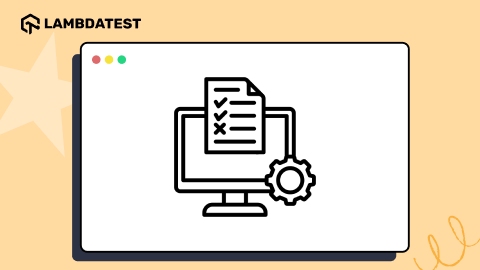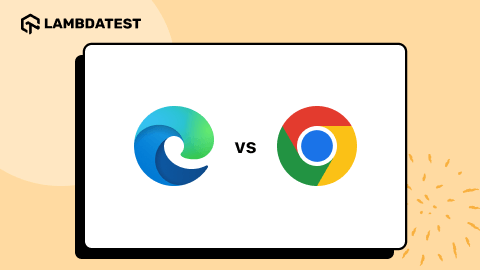Benefits Of Cloud Testing And Best Practices
Rileena Sanyal
Posted On: March 17, 2022
![]() 150467 Views
150467 Views
![]() 17 Min Read
17 Min Read
Imagining the digital world running through limited disk space on your computer sounds like a travesty, if not an illogical villain origin story! Cloud, therefore, is inevitable if you want to use anything on the Internet. The cloud is quite amazing when you think of all the great things it lets you do without hassles. The entirety of the online space runs on the basic principles of the cloud. As per Statista, the Cloud applications market size worldwide is expected to reach 168.6 billion U.S. dollars by 2025.

Virtualization became a catchphrase in the market a few years ago, and it developed, evolved, and eventually grew as Cloud computing. Cloud testing was carried out to ensure the quality of everything that is rendered in the cloud environment, using either manual or automated testing, or both. So what really is the cloud?
TABLE OF CONTENTS
- What is the Cloud?
- What is Cloud Computing?
- What is Cloud Testing?
- Why is Cloud Testing needed?
- Challenges of Cloud Testing
- Types of Cloud Testing
- What are the Benefits of Cloud Testing
- Cloud Testing Tools
- Real-World Example of Cloud Testing
- Choosing the Best Cloud Testing Provider
- Frequently Asked Questions (FAQs)
What is the Cloud?
Cloud is one of the basic requirements of the world today. Servers located across the world help you access resources online. This is typically what the cloud is. As a user, you are spared the horror of managing your own physical servers and using all your software on your machines. Moreover, you can use your files and tools from any device synced with the cloud, thereby helping you save local memory.
Cloud computing makes the technology much cheaper and more manageable for the IT industry. Servers no longer need updating and maintenance, infrastructure does not have to be strictly internal, and international operations take place with convenience. Therefore, clouds eliminate the boundaries. Remember the famous quote: ‘the world is a small place’? It is the cloud that makes it that.
What is Cloud Computing?
Cloud computing refers to cloud-based services offered by third-party providers. These services can include databases, networking, servers, intelligence, storage and aim to optimize resource utilization, promote flexibility and facilitate scalability. As a result, cloud computing lowers operational expenses while providing a powerful ecosystem for better IT-related tasks.
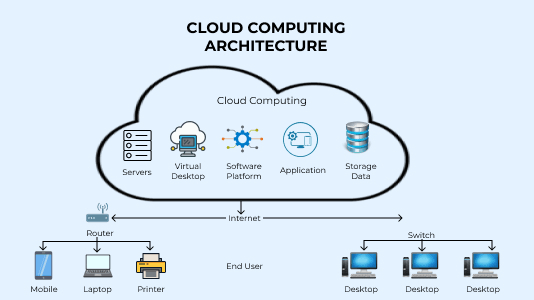
The services hosted on the cloud can be broadly divided into three categories. These are as follows:
- Infrastructure as a Service or IaaS: Often referred to as ‘the building block of the cloud’. In IaaS, companies aim to provide servers, network devices, and storage to their consumers as a form of service.
- Platform as a Service or PaaS: Platform as a Service was developed to help users explore the possibilities of developing, running, and managing multiple applications on the cloud, without interrupting or utilizing the inherent capabilities of the device’s operating system.
- Software as a Service or SaaS: Probably the most popular cloud computing service. Hosts allow their consumers to use certain centrally hosted applications against a subscription fee.
These are the three kinds of cloud computing services that are provided across the globe.
What is Cloud Testing?
In essence, cloud testing allows you to test your software on the cloud. This means you get to use your entire testing infrastructure on the cloud for web testing and application testing. Cross browser testing is made simpler using cloud infrastructure. Cloud-based platforms like LambdaTest offer cross-browser cloud testing services that help execute automated test scripts on the scalable cloud grid.
You can also Subscribe to the LambdaTest YouTube Channel and stay updated with the latest tutorials around Selenium testing, Cypress testing, CI/CD, and more.
Cross-browser website testing on a remote Selenium Grid cloud, for example, can be quite advantageous because automated tests can be run in parallel on the Grid. Without cloud testing, you need to maintain multiple devices with multiple browsers in multiple locations to test one software!
Also read: 19 Best Cross Browser Testing Hacks For Faster Release
Cloud testing, therefore, reduces the usage of resources like time, money, and workforce engagement. This is especially crucial for IT companies who have a limited amount of resources, thereby eliminating the burden of the manual testing process. Cloud testing can be broadly divided into three types.
- Testing resources of the cloud: Here, the cloud is treated as an entity of its own, and its resources are used for testing purposes, like performance and functionality. Such procedures involve testing the cloud provider’s services like PaaS (Platform as a Service) or IaaS (Infrastructure as a Service). Tests for disaster recovery, scalability, and data privacy may be performed in this process.
- Testing software native to the cloud: This refers to testing the SaaS (Software as a Service) products of a company that are stored in the cloud.
- Testing software with tools based on the cloud: Here, testing teams use tools that are based on the cloud to conduct their QA testing procedures. LambdaTest helps you test your websites and applications using automated scripts on the cloud grid. You can also use our cloud testing platform to conduct live testing on actual online browser ecosystems.
On LambdaTest’s automated cloud test platform, you can now run test scripts quicker than any other automation testing grid.
Why is Cloud Testing needed?
Cloud testing, on a broad spectrum, is of great use. It can reduce resource utilization, save time, money, and manual intervention on a big scale. Here are a few reasons why cloud testing is in much demand in the software development ecosystem around the globe.
- Cloud testing works wonders in reducing the testing time required for heavy applications. The ROI for automated cloud testing is massive compared to more traditional methodologies, owing to the flexibility and scalability offered by this process. Moreover, the resources consumed are drastically reduced in the case of cloud testing, thereby adding to the ROI. Hence, it is better to calculate the ROI of automation testing besides deciding on the budget.
- Cloud testing can be made available for several users on different devices for each, without any participating component interrupting another. This dramatically decreases the need for hefty infrastructure that would have required a company to shed a good amount of its pockets.
- Cloud testing is highly cost-effective due to its flexibility and compatibility with various ecosystems. Cloud testing can also be used by remote teams situated in multiple locations around the globe.
- Cloud testing offers high scalability and a more efficient testing cycle. Increased scalability demands quicker, more robust testing procedures that can often send traditional methods crashing down. Cloud testing, on the other hand, is well-equipped to handle such requirements.
- Cloud testing also offers increased mobility. Physical restrictions do not interrupt the development and testing procedures when the cloud is involved.
Challenges of Cloud Testing
Although a convenient method to perform complex procedures, cloud testing can still be challenging in many cases. This section on the benefits of cloud testing outlines a few things that users should be cautious about while performing tests on the cloud.
- Security and issues around data privacy: Security and data privacy issues may be looming behind unless the cloud is carefully monitored and precautions are taken to preserve privacy. Security is always hard to retain in a shared environment. However, plenty of cloud testing providers like LambdaTest provide robust security solutions to their users. LambdaTest is also compliant with leading security standards – SOC2, GDPR, and CCPA.
- Problems of using multi-cloud models: Multi-cloud models typically consist of various kinds of cloud, like public, private, and hybrid. Complexities around security, synchronization and other issues arise when several cloud providers are associated together.
- Ecosystem development: There may be plenty of issues around specific configurations of the server, network, and storage that can hinder cloud operations. It is additionally cumbersome to replicate a user’s ecosystem as it is not always possible to circumvent discrepancies. Furthermore, the modules that must be tested may be on the outskirts of the testing environment’s control limits.
- Bandwidth troubles: Bandwidth issues can arise due to shared resources on the provider’s end. Unless managed with greater efficiency and maximum tech support, it may be tough to handle heavy traffic with limited infrastructure.
Also, Read – Top 9 Challenges In Automation Testing [2022]
Types of Cloud Testing
Cloud testing is a vast subject under cloud operations. It can further be divided into the following types:
- Functional testing: Functional testing in a cloud environment entails testing all of the system’s features and functionalities, including hardware and software. It is usually carried out on a fully integrated software platform to ensure that it complies with the standards.
- System Testing: System testing ensures that an application in the cloud performs well under a given range of system requirements.
- Interoperability Testing: Interoperability testing checks if an application present in the cloud is flexible and compatible enough to keep performing with the same efficiency after a change in infrastructure.
- Acceptance Testing: Acceptance testing ensures a particular application on the cloud is aligned with the expectations of the consumer base.
- Availability Testing: Availability testing is more of an admin’s job where they are to ensure the cloud services are available round the clock and other things happening in the cloud do not interrupt the functionality of the application in concern.
- Multi-tenancy Testing: Multi-tenancy tests check if an application present in the cloud is performing the way it should in spite of heavy traffic and multiple user requests appearing simultaneously.
- Performance Testing: Performance testing can typically be divided into two categories- Stress testing and Load testing. These tests ensure that an application present in the cloud is competent to handle a given number of user requests. The cloud must also have a certain degree of elasticity to allow an increase in usage demands if required.
- Security Testing: Security testing ensures only individuals with proper authorization can access some data, and the information stored in the cloud always has extra layers of protection. For example, LambdaTest is a cloud testing platform with SOC2 certification and is compliant with GDPR and CCPA. This means that all our services are SOC2 compliant, ensuring our client data’s safety, management, and privacy.
- Disaster Recovery Testing: Sometimes, it may so happen that the data stored in the cloud may be lost due to unforeseen circumstances. Disaster recovery testing checks to see how fast this data can be recovered and to what extent.
What are the Benefits of Cloud Testing
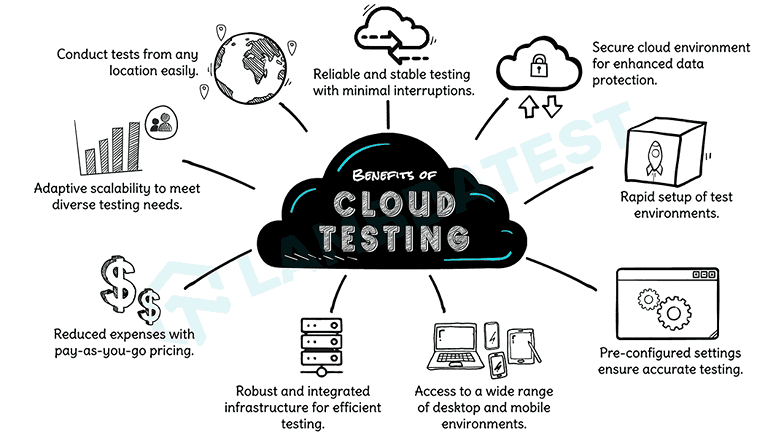
The benefits of cloud testing include the following:
- Cost-effective: Since consumers only pay for the resources they use, cloud testing tends to be a lot more cost-effective than traditional methods of testing apps.
- Availability: If there is a network connection, resources can be easily accessed anywhere and from any device. Therefore, physical restrictions like location are completely eliminated from the QA testing procedure. Moreover, testing teams can collaborate in real-time to work on the cloud testing process owing to the in-built tools present to facilitate collaboration.
- Scalability: Cloud testing has the provision to facilitate the scaling up or down of computing resources, as per the requirements of the testing procedure. For example, you can use the LambdaTest Concurrency Calculator in determining how many concurrent sessions you’ll require to speed up your test build process.
- Quicker testing process: Cloud testing processes are much faster than traditional testing procedures. This leads to a quicker initiation of the marketing process.
- Disaster recovery is much simpler: Disaster recovery methods are simpler for the cloud than they are for traditional procedures. Cloud disaster recovery (CDR) is a service that is offered to help firms recover critical data after a mishap- like data breaches. A safe virtual environment is used to remotely access the files. This makes disaster recovery a fairly simple process, eliminating extra hassles.
Cloud Testing Tools
Cloud testing is a simple, convenient method for mobile application testing and web application testing without worrying about the local cyberinfrastructure available to you. Testing on the cloud helps you utilize different machines and various ecosystems online without exhausting your resources on eliminating limitations like OS coverage, devices, and browsers.
You can test your website from different locations. There are cloud testing platforms like LambdaTest that offer 3000+ browsers and real devices on the cloud. LambdaTest’s cloud-based Selenium automation testing tools also integrate with popular test management and reporting tools, allowing you to analyze which tasks can be automated.
Here are a few tools that facilitate the automation of cloud testing procedures to make the process infinitely more manageable and scalable for you. You can select the best test automation tools based on your desire and budget and categorize them depending on the applications you are willing to test.
- SOASTA CloudTest: SOASTA CloudTest is a cloud testing automation tool that allows four kinds of automated performance and automated functional testing.
- Functional cloud testing for mobile devices
- Performance cloud testing for mobile devices
- Functional cloud testing for web-based applications
- Performance cloud testing for web-based applications
CloudTest facilitates the simulation of more than a million users across the globe to check the load handling capacity and performance of an application or website.
The tool also provides data analytics in real-time and seamless integration of testing, monitoring, and reporting modules to facilitate efficient cloud testing procedures. CloudTest Lite is the lightweight version of the SOASTA CloudTest automation tool.
- LoadStorm: LoadStorm is a perfect choice to test the load-taking capabilities of mobile and web applications. The tool is user-friendly and affordable. LoadStorm has high scalability with the power to simulate multiple users to reach the breaking point of the app.
Load testing scenarios on LoadStorm can also be customized to suit the unique requirements of the application. - Nessus: Nessus is a great tool for scanning vulnerabilities, missing modules, and poorly or incorrectly configured features in a variety of devices, cloud infrastructure, firewalls, etc. Testing teams and developers can use it to detect the presence of malicious elements like malware and web services linked to questionable sources.
Nessus also supports compliance auditing, a crucial service for the banking and healthcare sectors. All the reports and recommendations that the tool generates are in easy-to-use formats, including emails for targeted users.
Real-World Example of Cloud Testing
Developers build websites and applications all the time. When the main features of a project have been developed, the website or app must be tested thoroughly to ensure they are ready for the real world. Tests are conducted to check functionality, compatibility, security, performance, scalability, reliability, etc.
However, owing to massive levels of device fragmentation on a global level, the tests must be run on real devices and in the real-world ecosystem to ensure they will not falter when a human uses them. When we talk about mobile device fragmentation, we almost always refer to the Android operating system. If we merely look at the Android OS version, for example, it has the following market share:
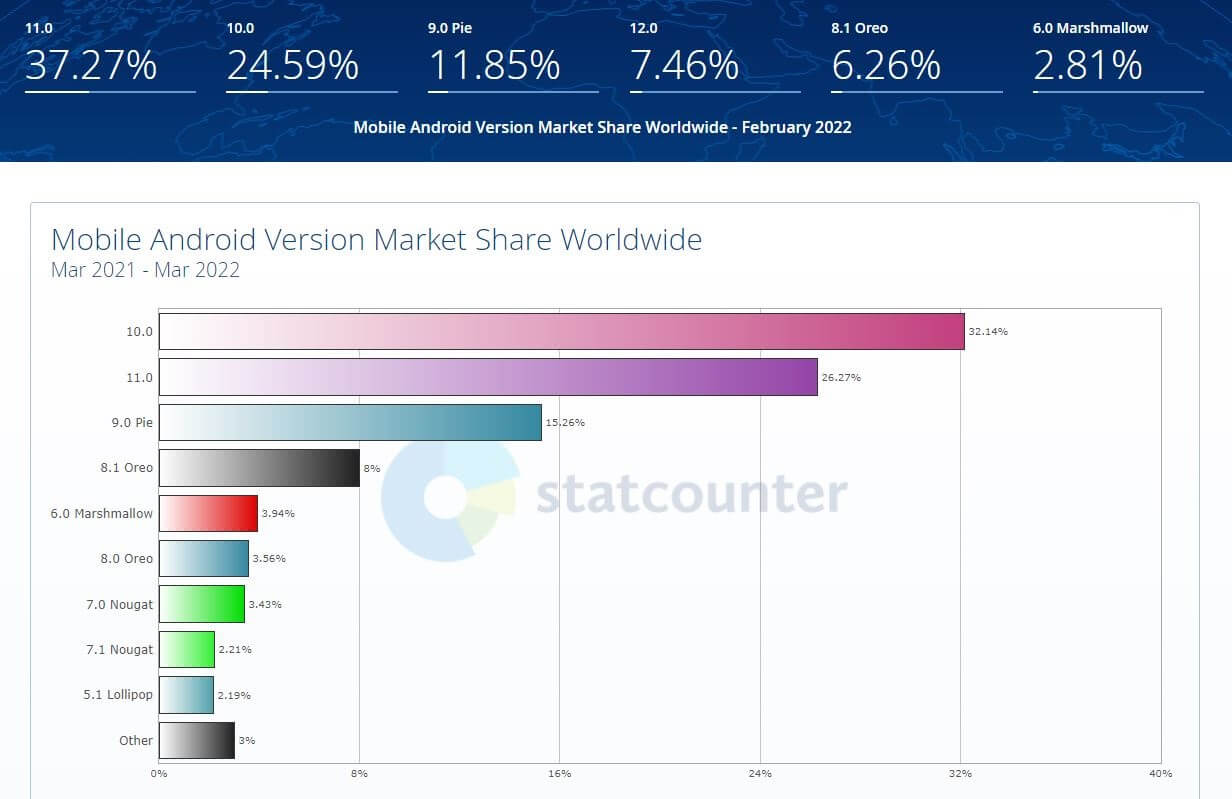
Setting up an infrastructure consisting of thousands of actual devices to check one website or app sounds witless.
To avoid this, cloud testing was introduced. Here, testers get access to almost all the devices being used across the globe and to multiple tools that can help them carry out all their tests in less time. Cloud testing spares companies the resources that a device lab would have demanded and makes a simple process much simpler and more exhaustive.
Also refer: How To Deal With iOS Version Fragmentation – LambdaTest
Looking to perform Android and iOS app testing on Real Device Cloud, check out our video below –
Choosing the Best Cloud Testing Provider
In this section on the benefits of cloud testing, we look at the factors to consider when selecting the cloud testing provider.
- As a first step, it is imperative for developers and testers to narrow down to one platform that provides all the devices and browsers that are popularly used across the globe, especially by the target audience of the enterprise in question. For example, LambdaTest provides an online browser farm of 3000+ browsers and OS to run tests on. These are real machines, operating systems, and browsers that ensure an application is aligned with the demands of its desired end-users.
- However, before choosing the ideal cloud testing partner, extensive research must be put in to understand if the company is providing a secure environment, round the clock tech support, and the tests are being conducted quickly and efficiently. The ideal partner should stand true to the real purpose of moving tests to the cloud- a faster testing process without any compromise on quality or security.
- Additionally, a cloud testing provider must also have provisions to incorporate a team of testers and a manager to keep track of the progress. And this entire suite should not be expensive as that would defeat the purpose of moving to the cloud.
Watch this webinar to learn about enterprise-wide actionable strategies, the dos and don’ts of automation testing and DevOps tooling that will help you improve the release and test velocity.
Summary
Developers are responsible for building websites and applications that are required to undergo tests before they can be launched for end-users. Hence, conducting the tests in a real-world ecosystem is necessary.
However, setting up a device lab consisting of thousands of devices would be a costly and ineffective affair. Therefore, cloud testing providers have the provisions to facilitate device and browser compatibility testing on the cloud. LambdaTest provides 3000+ real machines, operating systems, and browsers to its clientele for testing purposes.
However, before choosing a cloud testing partner, one should be wary of the devices and browsers being provided. Extensive research should also be conducted to ensure the cloud infrastructure is secure, reliable, fast, and overall cost-effective in the long run.
Cloud testing is therefore cost-effective, scalable as per requirements, is a much quicker process, customized for the benefit of the testing teams, and has a much simpler disaster recovery process. It even helps in solving the biggest remote testing challenges.
Organizations can accelerate their testing efforts and improve the quality of their products by utilizing parallel execution on LambdaTest’s cloud-based Selenium Grid. However, it’s also time for your team to make the changeover!
Frequently Asked Questions (FAQs)
What are the benefits of cloud testing?
The benefits of cloud testing include the following:
- Cost-effective infrastructure as compared to traditional testing methods.
- Remote access facility to allow cloud testing from any part of the world by people present in varying geographical locations and time zones.
- High scalability to scale up or down depending on the requirements.
- The testing process is quick and much more efficient as compared to traditional procedures.
What are the hassles of cloud testing?
Cloud testing can come with the following challenges:
- There may be security and data privacy issues due to shared resources on the cloud. However, these can be avoided with holistic security measures.
- Multi-cloud models, especially when shared by several cloud service providers, can cause problems around synchronization and security.
- Simulating a user’s environment may not always be possible, and the outcome could still retain some discrepancies. Some tests may also be beyond the scope of the testing ecosystem and hence may crash.
- There may arise issues related to bandwidth if the cloud infrastructure cannot handle heavy traffic.
How do I know cloud testing is for me?
Cloud testing is for anyone who has an application or a website that they want to test across all possible test cases, devices, and browsers. If you have an application or a website, cloud testing is for you.
How to choose the best cloud provider suitable for my needs?
Follow the steps given below to choose your cloud testing provider:
- Understand the kind of use cases your consumers will have.
- Research and narrow down on a couple of providers who are offering what your target users typically use.
- Talk to all these companies and ask as many questions as you find relevant to your requirements.
- Choose the one that is most aligned with what you need.
Got Questions? Drop them on LambdaTest Community. Visit now








